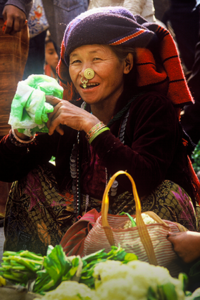 
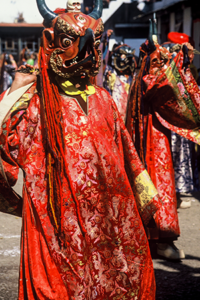 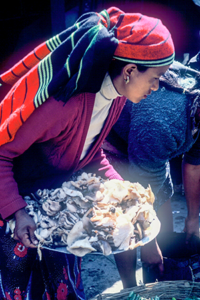 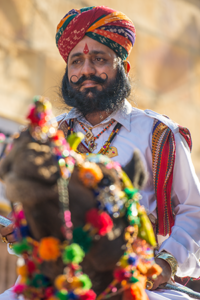  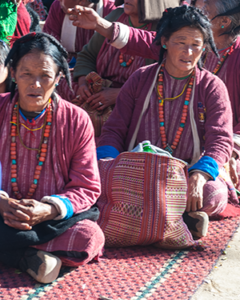 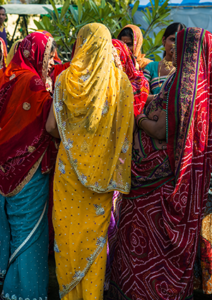 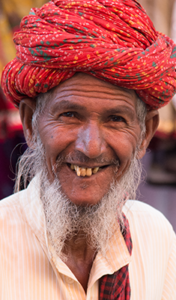 |
I don’t know another country that has inspired so much great writing! I’ve listed a few of my favorites, but even the 450 books on my shelves just scratched the surface of what’s available. GUIDEBOOKS DK/Eyewitness India This is probably the best book to start with if you know you want to go to India but can’t decide exactly where. It’s also a perfect book for people on group tours who want to know a little about India before they start off. It’s full of pictures and descriptions as well as easy to follow maps and has tons of background cultural and historical information. It does not, however, have much in the way of practical –how to get around – information. Some upscale hotels and restaurants are listed in the back but it is limited. It may be too heavy to take with you, but it’s definitely worth copying a few pages to take. Insight Guides Similar to the DK books in as far as having pictures and background information. It’s a little more “chatty” than DK and doesn’t cover as many places. It would be really good if you are off with a group tour to see the highlights. Lonely Planet India Travel Survival Kit Don’t leave home without this book if you will be vagabonding on your own. The absolute best to help you get where you’re going, find an inexpensive hotel or restaurant, and live on the local economy. There are lots of graphs with fairly complete train information – names, schedules and travel times. The 2015 edition is 1248 pages, and weighs 2 lbs, 1oz (950 grams) so it’s going to have to be your best friend. The good is that it lists all those secret little hide-away places, but the flip side to this is that it doesn’t have much space to go into much depth about each and every place. If you’re serious about learning about what you are seeing, you’ll need to carry along another book like “The Blue Guide” There are several break-out editions: Rajasthan, Delhi and Agra ( 288 pages) Goa and Mumbai (256 pages) South India and Kerala (544 pages) The Rough Guide, India Ever so slightly different than Lonely Planet, and perhaps a little better if your itinerary is laid out in advance. There is some info on trains and buses but it is not as extensive. It’s the same weight – 2 Lbs, 1 oz, but devotes a little more time to explaining the sights that you will be seeing. Footprints India Handbook Smaller font and lighter paper make this 1414 page book actually a little smaller than the Lonely Planet. The 2016 edition weighs 1 lb, 5oz (598 grams). This might be a better option if you have your itinerary and transportation lined up, as it only briefly notes the buses and trains. It’s lack of planning information (as compared to Lonely Planet, I would guess) has earned it only 2 stars on Amazon. Personally, I like it a lot, but I use other resources to plan my trips. It doesn’t list as many budget (one $) hotels as the Lonely planet does, preferring to give more space to mid-priced hotels. It also goes into more depth of information about the sights. I also like the way they draw their maps, and it has a good section in the back with history and religion. It has several smaller breakout editions: Delhi and the Northwest Handbook (2016) South India Handbook (2015) Kerala Handbook (2016) Chennai and Tamil Nadu (2014) Rajasthan, Delhi and Agra (2016) India: The North – Forts, Palaces, and the Himalayas (2013) Indian Himalaya – Leh, Utterakhand, Darjeeling and Sikkim (2014) Delhi to Kolkata (2014) Fodor’s Essential India This is a great choice for travelers who have a car and driver or on a tour and are hitting the highlights of India. It covers Delhi, Agra, Kolkata, Mumbai, Kerala. In Rajasthan, it has Udaipur, Jodhpur, Jaipur, and Jaisalmer. Fodor’s is always one of the best for mid to upper priced restaurant recommendations, and it has good places to shop. Michelin Green Guides There are 2 – Delhi, Agra, and Jaipur and Chennai and Tamil Nadu. I don’t know why I had trouble laying out an itinerary with these books – there is a bit of information on getting there and around. The layout of the land just didn’t seem to come together in my mind. But, if your plans are made, they are fantastic. At 8.5 oz and 11.2 oz respectively, they are small enough to fit in a carry-on bag and they are very big on information. Lots of background information at the beginning and great descriptions. Michelin rates the sites with stars so you can decide what’s most important. There is some hotel information, restaurant recommendations, and shopping tips. The Blue Guide to India If you love history and architecture, this is the book for you. No travel tips, no hotels, only a few restaurants, just lots of in depth information about the monuments you’ll be seeing. Indian Trains at a Glance Train timetable, available at most train stations in India for 20 Rupees. It is more complete than the old – now out of print – Cook’s Timetable, but available only in India. Banaras – Walks through India’s sacred city Nandini Majumdar. Never be lost in this wonderful city again! Mr. Majumdar is a native and he has broken up the heart of Varanasi into 12 guided walks with all the historical and mythological “scoop” This little book is full of pictures and maps, restaurant and shopping tips. Delhi – If you are just going to Delhi, there are several good options: DK/Eyewitness has a “Top 10 Delhi” that is great. Moon has a “Spotlight Delhi” – very good but no photos. My favorite guide to the off-the-beaten-track treasures is “111 Places in New Delhi That You Must Not Miss”. Really interesting walks in North Delhi are outlined in “Delhi, Ten Easy Walks”. HISTORY A history afficianado would do well to read up a bit before hand. There are some real smoke and mirrors revisionist history stuff going on at the moment, especially with regard to the Indo-European era. The Great Moguls Bamber Gascoigne. An introduction to the history of the Mogul empire that is an easy and fun read, with lots of pictures. A little hard to locate in the USA, but readily available in India. A Concise History of India Francis Watson. A great book for visitors to India who want to know something about Indian history but want to save precious brain cells for some other pursuit. It’s fun and easy to read and has lots of pictures. A Traveller’s History of India SinhaRaja Tammita-Delgoda. A very readable introduction to Indian history. It hits the highlights and most interesting aspects of history that the traveller is most likely to encounter. There is an excellent chronology in the back. India Michael Wood. Both the book (with lots of photos) and the accompanying DVD are great introductions to the history and culture of India. This is not a detailed chronology of Indian history. He paints Indian history in broad strokes and cultural movements which presents kind of a different take on things. A New History of India Stanley Wolpert. A bit more serious than the above mentioned books. It has some good insights regarding the impact of the various religions and social movements that have swept across Indian history. What it lacks (along with illustrations) is very much information on South India and the Deccan. A History of India Burton Stein. One should have a pretty good background in Indian history before launching into this book, but with that in mind, it is an excellent and scholarly review of Indian social history. He has the most up to date theories on the Harappans and the Aryans and has a knack of making sense of the fragmented medieval kingdoms of South and Central India. The Peacock Throne Waldemar Hansen. A history book that reads like a fascinating, page turner novel, complete with all the bazaar gossip of the time. The story deals mostly with the reigns of Shah Jahan and Aurangzeb. (This book may be out of print – try the library or buy it in India) A History of India, Part 1 Romila Tharpar. This is one of the few readily available books dealing in depth with the history south India. It was written 40 years ago so some of the information is outdated, but overall, it is very useful. Romila Tharpar is one of India’s most eminent historians and has also written the definitive book on Ashoka, called “Ashoka and the Decline of the Mauryan Empire”. Raj (The Making and Unmaking of the British Empire) Lawrence James. An unabashed Euro-centric approach to Indian history, but that’s what makes this book so interesting. If you are interested in how and why the Raj operated, this book will delight you with intriguing new insights – some of them flattering, some of them not – on how the British governed millions of Indians. The good, the bad, and the ugly of 200 years of colonialism. Freedom at Midnight Larry Collins and Dominique LaPierre. A nicey-nice story of the dissolution of the Raj and the partition of India in 1947 that doesn’t trash anybody too badly and makes the British look good. This book is well researched (much of it taken from the personal archives of Lord Mountbatten) and deals with the power struggles between Nehru, Jinnah, and Gandhi. Midnight’s Furies Nisid Hajari. Using some recently opened archives, this book – written in 2015 – takes a harder look at the competing personalities involved in the partition of India. No one comes off looking particularly well, but it is very informative. ART AND ARCHITECTURE The Art and Architecture of the Indian Subcontinent J.C. Harle. A very comprehensive overview of Indian Art. Not the most flashy art book on the market at the moment, but a good place to start. Hindu Art T. Richard Blurton. Chapters devoted to the Hindu temple and to the major Hindu gods and goddesses. This book approaches the art through religion so that you will come away with a better understanding of Hinduism Moghul Architecture and Gardens George Michell. Beautifully illustrated guide to the best Moghul architecture. George Michell is one of the leading authorities on Indian architecture – Moghul, Hindu, and Jain. Many of his books are now out of print, but can be bought used. Taschen’s Art and Architecture of India This is the book to “wow” you with color photographs on almost every page, and descriptions of the major Hindu sites. Indian Architecture (Islamic period) Percy Brown. One of the best for detailed technical descriptions of the major Islamic monuments. It’s mostly text – there are few pictures, and only black and white at that. The History of Architecture in India Christopher Tadgell (Phaidon Books) A bit more scholarly than the Taschen books but not quite as colorful and visual. He describes, in a very readable way, the development of the architectural styles through the many cultures of India. Ancient Hindu Geometry, the Science of the Sulba Bibhutibhusan Datta Sacred geometric theories are fundamental in the design of both Hindu temples and Islamic mosques. This book will give you some background into temple building, from its conception in the Vedas through some of Hinduism’s less ancient sutras. For a more general overview of sacred geometry, try Robert Lawlor’s excellent book, “Sacred Geometry”. Indian Art Vidya Dehejia. (Phaidon Books) This book interprets the art which you are seeing and puts it into historical and cultural context. It certainly is not the most complete listing of Indian works of art, but it is full of wonderful cultural insights. Paradise as a Garden Elizabeth Moynihan. A Persian/Mogul garden is not just a beautiful collection of plants. From the time of Cyrus the Great in Persia, every tree, every pathway, every watercourse, is steeped in symbolism and hidden meanings. RELIGION AND CULTURE Nine Lives William Dalrymple. In interviews with 9 different people of different faiths who are living spiritually imbued lives. Mr. Dalrymple takes a look at India’s spiritual landscape as it meets the modern world. Indian Textiles John Gillow. Everything you have wanted to know about textiles in India, from tribal to the most elegant silks. It’s full of pictures and diagrams as well as a glossary of terms and a listing of museums. An Illustrated History of Hinduism Rasamandala Das A beautifully illustrated introduction to Hinduism. This is large paperback 96 page book, but the same author has written a larger, 256 page, The Illustrated Encyclopedia of Hinduism. Both are great, just depends on how much you want. Banaras, City of Light Diana Eck. A “must read’ for anyone wishing to begin understanding the complex way of life called Hinduism. And, in the process, you will come away with a love for Varanasi. Ms. Eck is professor of Comparative Religions and Indian Studies at Harvard. The Spiritual Heritage of India Swami Prabhavananda. An overview of the major religions of India from a Hindu’s point of view. This book has a section with very understandable discussions of the Vedas, Upanishads, and the Gita. The Illustrated Encyclopedia of Buddhist Wisdom Gill Farrer-Hallas. A great introduction to Buddhism. It’s full of photos and illustrations and describes all the main Buddhist traditions. Introduction toTibetan Buddhism John Powers. When you’ve decided that you want to understand the workings of Tibetan Buddhism a little better, this is a good choice. The original version, published in 2007 has 592 pages. In 2008, he published a “Concise” version with 160 pages. Both great, just depends on how much depth you want. Indo-Tibetan Buddhism David Snellgrove. Recently reprinted into one volume, this is one of the classics of Buddhist history. Pure history, no religious dogma. The story of how Buddhism developed in India and spread to Tibet. A Guide to the Buddhist Path Sangharakshita. Written by a western Buddhist, this book describes the precepts and practice of Mahayana Buddhism. There are drawings and explanations of the deities that you will find in the monasteries. The Tantric Mysticism of Tibet John Blofeld. A well-rounded explanation of Vajrayana Buddhism, but it may be a bit much for the casual traveller. For someone with the basics, however, this is one of the best “next steps”. Out of print, but available used. The Art of Tantra Phillip Rawson. An introductory look at tantracism as it applies to Buddhism and Hinduism. Kindness. Clarity, and Insight H.H. Dalai Lama. A series of talks given by the Dalai Lama explaining the attitudes and practices of Buddhism. Ladakh Neetu Singh and D.J. Singh. (Available in India) Fabulous photos and well written text make this one of the best guides to the history, culture and religion of Ladakh. Very little practical travel information The Sufis Idries Shah. An introduction to Sufism written by one of the leading spokesmen for the Sufis. Sadhu Dolf Hartsuiker. Sadly, this beautiful little book is only available in paperback, because it deserves to be a hardback. Mr Hartsuiker has distilled the complex and overwhelming philosophies that drive the 4 or 5 million sadhus gracing India’s religious landscape. Besides all the insights, it’s full of gorgeous photos. Travel Literature City of Djinns William Dalrymple. A little history, some meetings with fascinating people, and a lot of cultural insights make this hilarious book a joy to read. Mr. Dalrymple lived and worked in Delhi as a reporter and has experienced this city in a way that few outsiders ever have the privilege to do. The book won the 1994 Thomas Cook Travel Book Award. The Heat and Dust Project Devapriya Roy & Saurav Jha. An Indian couple, fresh out of college but not quite ready to settle down, embark on a backpacking trip through India on 500 Rupees a day. It’s how we wish our trip would work out, and perhaps their experiences will guide us along. Lots of anectodes and insights into Indian culture and mythology. Around India in 80 Trains Monisha Rajesh. The first chapter is called “All Aboard the Insomnia Express” which alerts you to Ms. Rajesh’s impending wit and wry humor that make this such a fun book. If you are going to be on a lot of trains in India, this one will help you with the insider tips. It will also help you keep your sense of humor during those sure-to-happen trying moments. Lost and Found in India Braja Sorensen. An Aussie woman, along with her Danish husband, moves to a small town on the Ganges and finds the home of her heart. Imagine a “finding enlightenment” genre book written by a highly realized person, and you will have this wonderful book. This book, along with the first 5 chapters of “Shantaram”, would be my suggestions for trying to understand the heart and soul of Hindu India. Ms. Sorensen has a blog and has written several other books. The Kama Sutra Diaries Sally Howard. If you have ever wondered how India can have both erotic temples and Bollywood movies that barely manage a kiss, this will help explain all the contradictions. Highly recommended for women traveling on their own as it help you understand and avoid all those annoying and sometimes frightening sexual advances. Travels On My Elephant Mark Shand. On a lark, Mr. Shand buys an elephant named Tara and sets off with her and her mahout. During their trip across eastern India, he learns about elephant care, the cult of Ganesh, and life in small Indian villages. And, of course, falls in love with the plucky Tara. Rogue Elephant Simon Denyer. For most of his career, Mr. Denyer covered the Indian subcontinent and Afghanistan for various news organizations. This book has all the lowdown – the good and the ugly of Indian politics. NOVELS A Suitable Boy Vikram Seth. Acclaimed by some as the “best novel of the 20th century”, this rich and intricately woven tale is the story of three families in newly independent India of the 1950s. Vikram Seth manages to include almost all aspects of Indian culture into its storyline, from dating to saddhus. By the time you finish the 1400 pages of this book, you will be just “one of the family”. A Fine Balance Rohinton Mistry. Heartwrenching and uplifting, devastating and hopeful. This is a special and beautiful novel of four mismatched people thrown together through a twist of circumstances. Mr. Mistry’s one line zingers which capture the hilarity or pathos of a particular aspect of Indian life will come back to you and bring a smile as you too confront that situation in your journeys. White Tiger Aravind Adiga. This is a Booker Prize winner, and for very good reason. Mr. Adiga’s writing is edgy, gritty, sardonic, and quite amazing. Oh – and the story’s great, too. A chauffeur – with much hanky-panky – claws his way to wealth. A book that lays bare the socio-economic challenges going on in India. Shantaram Gregory David Roberts. My current “favorite” novel of India, even though it was published in 2005. Roberts is an amazingly precient, insightful, and gifted writer who captures the spirit of ordinary Indian people. It’s set in the slums of Mumbai, but he speaks for all the people of India. It sounds intimidating at 902 pages, it goes fast because you won’t be able to put it down. The sequel, “The Mountain Shadow”, continues with Lin’s involvement with the mob. Not my favorite part of his adventures, so it left me a bit cold – but it’s a great book if you like the mob scene. Kim Rudyard Kipling. Kipling’s most famous book, and with good reason. A young English boy, “gone native” sets off with a lama to search for a holy river. Northwest Frontier intrigue and adventure at its best. Far Pavilions M.M. Kaye. A soapy romantic historical novel that does a beautiful job of capturing the spirit of princely India. (Do NOT be tempted to watch dreadful the video! ) Heat and Dust Ruth Prawar Jhabvala. Although written in Ms. Jabvala’s style of hopelessness and despair, this romantic story offers some real insights into the relationships between the Indians and British during the later part of the Raj. The Moor’s Last Sigh Salman Rushdie. Set in Bombay, this novel is a slice of Indian high society and political skullduggery. Rushdie is the master of creative English language. If you read for a sense of place or for love of language rather than plot or action, this book could be your ticket to Nirvana. His book, “Midnight’s Children”, the story of a man whose life mirrors India’s growth pains, won the 1993 Booker of Bookers award. The God of Small Things Arundati Roy. A Christian family in Kerala faces a host of social dilemmas when tragedy strikes. Written in a similar ethereal, poetic style as “The English Patient”, this book also won the Booker Prize. A Passage to India E. M. Forster. The West misunderstands India with disastrous results in this beautifully written book. The movie was great as well. The Jewel in the Crown (Raj Quartet) Paul Scott. A richly woven and complicated tale of many lives, both English and Indian, at the close of the Raj. The 1984 Masterpiece Theatre series is beautifully done. TELLING IT LIKE IT IS Behind the Beautiful Forevers Katherine Boo. Winner of many awards, this book chronicles the lives of the poor in a Mumbai slum. Heartbreaking but inspiring, it is one of the best books I have found for understanding the underbelly of India. For vagabonding travelers it is an essential read before you go in order to fully understand the depth of the pay-off schemes, kick-backs, and corruption you will be faced with. Other travelers may want to leave it until they get home so as not to scared off. Maximum City Suketu Metha. After growing up in New York, Mr. Metha returns to India with his family to re-acquaint themselves with their native culture. What could go wrong? The End of Karma Somini Sengupta. No longer will India’s young be willing to accept “it’s karma” or “it’s tradition” to explain why they should accept a life of reduced circumstances. Nehru’s promised of a bright economic future have fallen short and the tech savey, highly educated millenials are restless. The Economist lists this book as one of the best of 2016. MAPS Gizi Maps – India 1: 3,000,000 Hands down, my favorite India map, but it can be hard to find. It’s clear and easy to read and the foothills, snow mountains, and rivers are clearly delineated. All of India is printed on one side and the reverse is all index. Just beware – it’s huge. Folded out, it’s 49in x 34in National Geographic India Adventure Travel Map 1:3,150,000 Smaller than the Gizi Map, ( 37in x 25in) but not quite as easy to read. It’s 2 sided, splitting India just below Bhopal. The physical geography is there, just not as easy to discern. It notes places of interest such as “pilgrimage center”. It is very adequate until you get to Tamil Nadu which is densly populated with monstrously long place names. Nellis Maps Visually, these are not the most eye-catching maps, but they do the job well. Films, DVDs and Movies Sarachna: The magic of ancient architecture (streaming on Netflix) Jodhaa and Akbar (DVD from Netflix and available to purchase, just be careful to get the right version for your country.) Have no illusions about this being historically accurate – all we do know is that Akbar had a happy marriage with some unidentified Hindu princess. But if this beautiful and dreamy film doesn’t make you fall in love with India, I don’t know what will. It’s filmed at the Agra Fort and several palaces in Rajasthan. Book Stores and Mail Order Books Distant Lands Travel Bookstore 20 South Raymond Ave. Old Pasadena CA 91105 (626) 449-3220 e-Mail: info@distantlands.com www.distantlands.com An enormous selection of travel books in a store with knowledgeable and helpful staff, some of whom are real Indiaphiles. Snow Lion Publications P.O. Box 6483 Itica, NY 14851 (800) 950-0313 www.snowlionpub.com Devoted almost exclusively to books on Vajrayana Buddhism Shambhala Publications P.O. Box 308 Boston, MA 02117 (617) 424-0030 www.shambhala.com Psychology, religion, philosophy, and art Michael Chessler Books P.O. Box 4359 29723 Troutdale Scenic Drive Evergreen, CO 80437 (303) 670-0093 (800) 654-8502 e-mail: chesslerbk@aol.com www.chesslerbooks.com Books on mountain climbing world wide. They carry a wealth of general information books on the Himalayan region and they are an excellent source for hard to find and out of print books. And in India: Bahari Sons Booksellers Khan Market (opp. Main gate) New Delhi 110 003 TEL: 469-4610 e-mail: bahrisons@vsnl.com Oxford Bookstore 17 Park Street Calcutta 700 016 TEL: 229-7662 |
